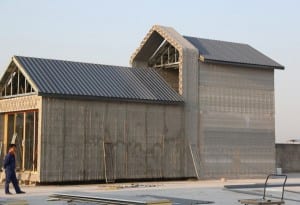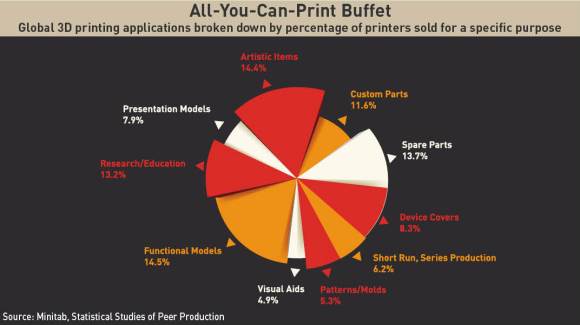 3D Printing – it sounds like something from science fiction, but a company in China has used 3D printing technology to build 10 houses in a single day. And there are 3D printers on sale in Officeworks right now. You could 3D print at home – although not something the size of a house!
3D Printing – it sounds like something from science fiction, but a company in China has used 3D printing technology to build 10 houses in a single day. And there are 3D printers on sale in Officeworks right now. You could 3D print at home – although not something the size of a house!
It’s only recently that the 3D printing industry, estimated to be worth over $3billion in 2012 and growing rapidly, has moved into consumer awareness. But it’s time to look a bit deeper.
3D printing has the potential to transform manufacturing.
The cost of labour becomes far less relevant. Economies of scale almost disappear. The first working 3D printer dates from 1984, but the technology did not become widely available until the 2010s. The market is now growing rapidly, with new applications for 3D printing being explored all the time, in fields as diverse as automotive, aerospace, fashion, biotech, construction, food and education.
It’s no surprise that China, the world’s largest manufacturer, is paying close attention to 3D printing. The country aims to have the world’s largest 3D printer and is investing RMB 1.5 billion in developing the technology.
So from China’s perspective, is 3D printing a threat, or does it offer opportunities as well?
Understanding how 3D printing works
3D printing is the process of making a 3D object by building up layer after layer of material extruded in different shapes. It is also known as ‘additive manufacturing’ – in contrast to traditional manufacturing processes like cutting or drilling where material is removed or subtracted to create the final object. Materials used to create objects are primarily plastics, polymers and metal alloys. A range of technologies are used to create and join the layers. As a general rule, more expensive printers have higher quality (thinner layers, allowing more accuracy) and more capabilities. They may be able to print more than one colour of the same material, or more than one material, at the same time.
Since 3D printing builds an object up layer by layer, it can be a slow process. The higher quality the printing (ie the more layers there are) and the bigger the item, the longer the job takes to print.
Constraints on adoption
Despite massive growth in the 3D sector over the last few years, there are still constraints to be overcome:
- It takes hours or even days to print an object. That’s not an issue for a design prototype, but for large scale production it’s simply impractical.
- Materials are expensive. Only certain materials and compounds are suitable for the various 3D printing processes. Purity and composition standards are higher than for standard manufacturing, even when the same material is used, so it can be 10 or 100 times more expensive. With only limited suppliers to the burgeoning 3D sector, there’s little competitive pressure on pricing.
- The printers themselves are expensive, often costing up to $1 million. So are other items of equipment, including lasers to meld the printed layers together and high-quality 3-D scanners to map objects.
Some of these challenges may be overcome with time. New materials suppliers are likely to enter the market, which should help bring prices down. As technology matures and patents expire, the cost of printers should also drop.
For the time being at least, 3D printing poses no threat to China’s mass production manufacturing. What will happen in 5 years is still to be seen.
Practical applications and implications for Chinese manufacturing
At the same time, there are opportunities for current manufacturing to take advantage of 3D printing. It’s already being used across the world for a range of purposes.
Prototypes can often be developed, tested and adjusted more quickly. China’s existing 3D printers support both Chinese and multinational companies in R&D efforts, speeding up the process of product innovation.
The same benefits apply for moulds used in the mass production process. Moulds are usually custom jobs, which often require manual machining or adjustment, so they are expensive and time-consuming to make. 3D printing can compete on equal terms. Dependent on the shape of the mould, the wastage may be much reduced, offsetting the cost of higher materials. It’s also easy to use a 3-D scanner on an existing item and reverse engineer a mould to make more of the same.
There are also hi-tech industries in China where 3D printing is already used for actual parts as well as prototypes. Aerospace can benefit from components with internal holes which keep weight down. Some automotive parts, if made by traditional methods, have a materials wastage rate of over 90%, which 3D printing can cut to single digits.
Other applications may not be so clearly advantageous for China. Mass customisation may erode the mass production market. Factories which make mobile phone cases with different designs may have to compete with websites where you can design and 3D print your own personalised case. Then again, the phones themselves, many made by Foxconn’s 1.3 million employees in China, are less vulnerable to this kind of competition. And mass customisation in a completely different industry may actually benefit China – imagine providing individually tailored prosthetics and medical devices to the emerging Chinese middle class.
***
Overall, it’s safe to say that 3D printing is changing the face of manufacturing, but it’s too early to say exactly how. What’s certain is that both government and industry are watching closely and investing heavily in the sector. China won’t let its manufacturing dominance fade without a fight. And we at Hornet are watching closely too.
For more information on 3D printing visit
http://en.wikipedia.org/wiki/3D_printing
Check out their story about a smartphone compatible lens to detect skin cancer, developed in Australia


